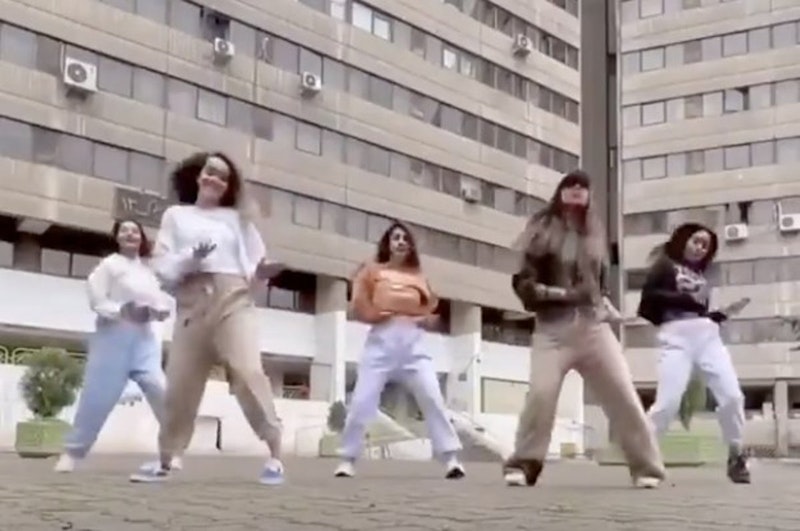On social media and in physical space, Iranians are dancing against their grim theocracy. Popping and locking might not seem like much to pit against the Revolutionary Guard's weapons and internment facilities, and I don't know whether it can be practically effective in any dimension. But I have the notion it might be, and also the notion that dance is intrinsically worthwhile whether it topples the local regime or not. I'd suggest that someone should be dancing at Xi Jinping, for example, the same way Pussy Riot danced at Putin. But in Iran right now, dance seems to be gathering into a mass movement of aesthetic civil disobedience.
The dance rebellion began in late-November, when a viral video appeared on Instagram of a 70-year-old fishmonger in the northern city of Rasht, neatly turned out in a white jacket and bopping happily as men around him clapped and sang. Sadegh Bana Motejaded is also known as Sadegh the Trumpeter or, so very appropriately, as “Bhoogi.” As some religious people do, Iranian clerics object to dance as an invitation to sin and too much fun to have with your body. They took down Bhoogi's Instagram page and replaced it with the logo of the department of justice of the Islamic Republic of Iran. They arrested 12 men who participated in his performance.
Before long, people all over Iran were dancing, and the videos really need to be seen to be understood. “My reason for dancing is to make people happy," said Bhoogi. “I only want people to be happy and to change their mood.” It seems to be working. Likely, he wasn’t trying to make a political statement, but now he's a political leader just in virtue of his fine moves. Even conservative Iranians think the government's response is ridiculous and counterproductive. "The government is showing how to make guerillas out of singers," said a news site usually sympathetic to the regime. "Honestly, this is a feat!"
"A revolution is not a tea party," Chairman Mao famously observed. Rather, it's a series of killings by which one class overthrows another. But there are joyful revolutionaries too, and they tend to be far less destructive. "If I can't dance, it's not my revolution," is a sentence attributed on thousands of 1970s t-shirts to the great Russian/American anarchist and feminist Emma Goldman. What she actually said (in her autobiography Living My Life) was this:
At the dances I was one of the most untiring and gayest. One young boy took me aside. With a grave face, as if he were about to announce the death of a dear comrade, he whispered to me that it did not behoove an agitator to dance. Certainly not with such reckless abandon, anyway. It was undignified for one who was on the way to become a force in the anarchist movement. My frivolity would only hurt the Cause. I grew furious at the impudent interference of the boy. I told him to mind his own business. I was tired of having the Cause constantly thrown into my face. I did not believe that a Cause which stood for a beautiful ideal, for anarchism, for release and freedom from convention and prejudice, should demand the denial of life and joy. I insisted that our Cause could not expect me to become a nun and that the movement would not be turned into a cloister. If it meant that, I did not want it.
Dance as an improvisational fully embodied response to music is just the opposite, we might say, of bureaucracy. The rule of law is positive, perhaps, depending on what the laws are, but living in rules with no moment or possibility of release is the essence of one kind of oppression. That in turn suits dance to be an essence of liberation. Ballerinas don't know that, maybe, but ravers do. Another group that knows the liberatory possibilities of dance are Sufi dervishes, who practice a form of Islam based on love, joy, and physical movement. They view Islam as a quest for liberation and unity. For that, you need to dance. The Iranian regime has repressed the Sufis too.
Many Iranians are treating the dance-dance revolution not as a regime-change opportunity but as a diagnosis of and treatment for a culture-wide psychological condition. A sociology professor at Tehran University, Fayaz Zahed, in something of an open letter to authorities, wrote, “Iranian society is tired, worn out, and sad. Let it be happy for a little while, even if it is a lie, make-believe, and fleeting.” He remarks that "Iranian society today is even sadder, more depressed, and in crisis than two decades ago."
It's "funny," really, that Tehran's own professors are diagnosing the whole society as suffering from sadness and exhaustion and prescribing dance as the cure. But it's the repression that changes disco or dervish dance into an act of rebellion, because it shows that the nature of the state is just intolerably depressing. The government of Iran and its tendentious reading of Shia Islam pits itself against the human body, in fear specifically of its capacities for exuberance, improvisation, and connection.
I like to think that you can't stop all the people from dancing all the time. For we are homo tripudio: the species that leaps, capers, sways, spins, twirls, gyrates, bops, struts, cavorts, frolics, gambols, frisks, prances, and romps. Al Khamenei, like Emma Goldman's young acquaintance, has committed one of the worst of all human crimes, parking on the dance floor.
—Follow Crispin Sartwell on X: @CrispinSartwell

